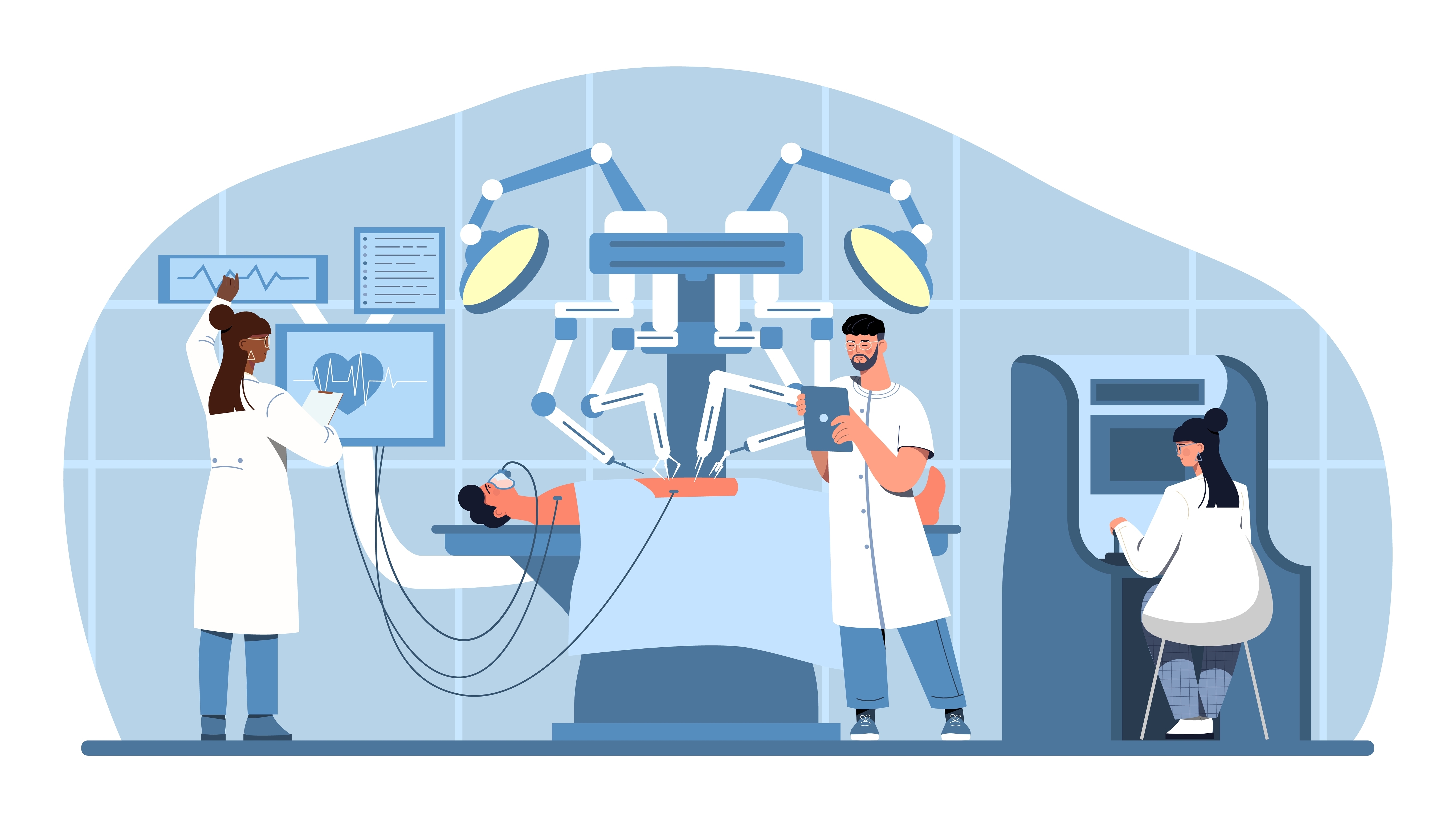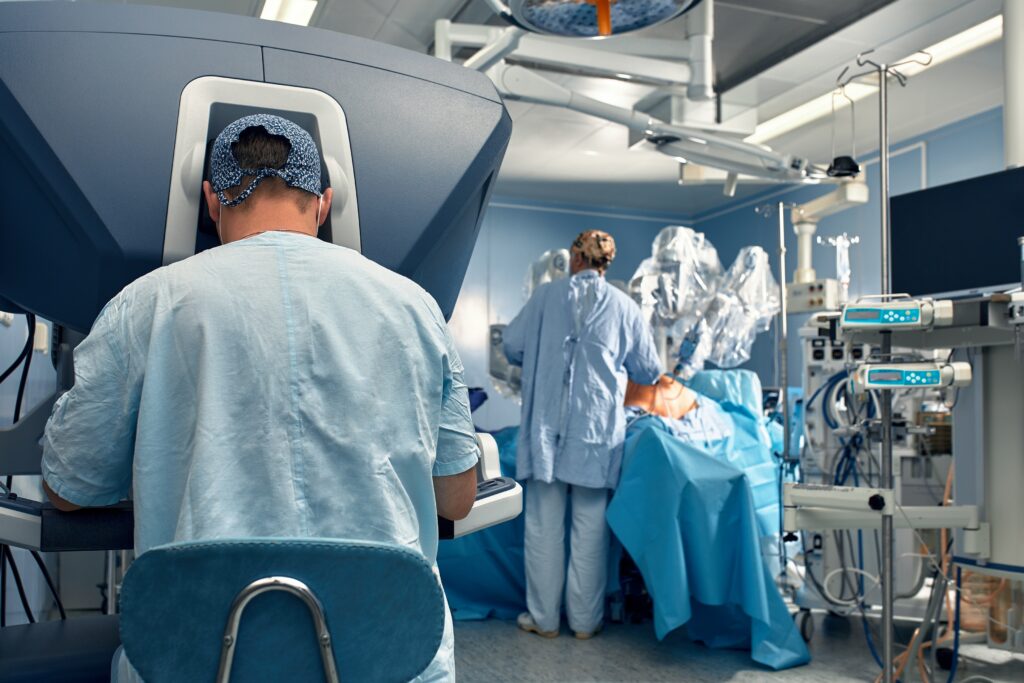ASOURCE®NAVI

公開日:2025.01.23
医療技術の進歩によって、近年はより安全で正確な手術が行えるようになりました。その中核を担うのが手術支援ロボットです。人間の手の限界を超える精密性と、術者の負担軽減を実現する手術支援ロボットは、現代医療に革新的な変革をもたらしています。今回から、4回にわたって最先端の医療機器について解説します。第1回は手術支援ロボットの現状と展望についてまとめます。
手術支援ロボットの分野は、近年急速な進化と多様化を遂げています。
世界で最も普及しているインテュイティブサージカル社の「da Vinci(ダヴィンチ)」は、4本のアームを持つシステムとして3D高解像度カメラによる立体視野と、人間の手の動きを精密に再現する機能を備えています。術者は専用のコンソールから操作し、従来では難しかった狭い空間での繊細な作業も可能となりました。泌尿器科の手術を中心に保険適応が拡大し、現在では消化器外科や婦人科などでも保険適用での手術が可能となりました。日本の主要な大学病院の多くに導入され、手術支援ロボットの中でも高いシェアを占めています。
日本の手術支援ロボット開発も着実に進展しています。メディカロイド社が開発した「hinotori(ヒノトリ)」は、多関節アームを備えながら、よりコンパクトな設計と直感的な操作性を実現しています。特に、アーム回りがスリムなことで、小柄な日本人女性にも使いやすくなっています。国内の手術室のスペースや手術スタイルに適合した設計となっており、泌尿器科や消化器外科領域での使用が始まっています。
さらに、2023年には東京工業大学、東京医科歯科大学の2つの国立大学※と、リバーフィールド社の共同開発による手術支援ロボット「Saroa(サロア)」が発売されました。本システムは、ダヴィンチやhinotoriと違い、触った感覚が手に伝わる「力覚フィードバック」機能があることが特徴です。視覚のみに頼るほかのロボットと異なり、より安全に手術が行えます。コンパクトな設計と高い操作性を実現しながら、従来のシステムと比較して導入コストを抑えることを可能にしています。
※2024年10月に両大学は統合し、国立大学法人東京科学大学となっている。
メドトロニック社の開発した「Hugo(ヒューゴ)」は、モジュール式の設計を採用することで、手術室での柔軟な配置が可能となり、さらにオープンコンソールの採用により、術者と手術チームとのコミュニケーションを円滑にする工夫が施されています。
アセンサス・サージカル社の「Senhance(センハンス)」システムは、腹腔鏡をロボットで操作するというコンセプトで作られています。既に病院が保有しているラパロ用の鉗子のスコープを利用でき、コックピットでの術者操作も腹腔鏡鉗子と同じ動きになるので、腹腔鏡に慣れた医師には扱いやすいとされています。独自の眼球追跡技術を搭載し、術者の目の動きに合わせてカメラを制御する革新的な機能を特徴としています。また、触覚フィードバック機能を備えており、より繊細な組織の触感を術者に伝えることが可能です。保険上も腹腔鏡手術として算定されます。

手術支援ロボットの多様化により、医療機関はそれぞれのニーズや予算に合わせてシステムを選択できるようになってきています。3D画像による正確な術野確保や手ぶれのない安定した操作は、すべてのシステムに共通する基本的な特徴となっており、最小限の切開による低侵襲手術を可能にしています。
各システムは独自の特徴を持っており、例えばSaroaやSenhanceの触覚フィードバック機能、Hugoのモジュール式設計、国産システムであるhinotoriやSaroaの日本の医療現場への最適化など、それぞれが特有の強みを有しています。特に国産システムの登場は、日本の手術室の特性や医療ワークフローに合わせた設計を実現し、より効率的な導入と運用を可能にしています。
しかしながら、これらの革新的な技術にも共通の課題が存在します。高額な導入・維持コストや専門的なトレーニングの必要性、機器の大きさによる手術室スペースの制約などが、現在の手術支援ロボットが直面している主要な課題となっています。
米国では、すでに多くの医療機関が手術支援ロボットを積極的に導入しており、年間手術件数は増加の一途をたどっています。特に前立腺手術や婦人科手術での活用が顕著です。選択肢の多様化により、各医療機関の規模や専門性に応じた最適なシステムの導入が可能となっています。日本国内においても、大学病院を中心に導入が進んでおり、保険適用範囲の拡大に伴い、実施件数は着実に増加しています。
手術支援ロボットの進化は、遠隔医療の実現にも大きな可能性を開いています。高速通信技術の発展により、専門医が物理的に離れた場所からロボットを操作して手術を行う「遠隔手術」の実現に向けた研究と実証実験が進んでいます。今年6月には神戸大学、ドコモ、NTT Com、メディカロイド、神戸市の5者による5G通信を活用した遠隔手術の実証実験が成功し、都市部の専門医が地方病院の手術支援ロボットを遠隔操作して手術を行うことが技術的に可能であることが示されました。遠隔手術が実用化されれば、地理的な制約を超えて高度な医療を提供することが可能となり、医療過疎地域における専門的な手術へのアクセス向上が期待されます。また、熟練医が遠隔から若手医師の手術をサポートしたり、緊急時に専門医の助言を得たりすることで、より安全で質の高い医療の提供が可能となります。
手術支援ロボットの役割を考える上で重要なのは、これらはあくまでも「支援」ツールだという点です。最終的な判断と責任は医師にあり、ロボットは医師の技術を補完し、より安全で正確な手術を実現するためのツールとして機能します。システムの多様化は、この医師とロボットの理想的な協調関係をより柔軟に実現する可能性を広げています。
メディアスグループは、医療機器の販売を中心とした事業を展開しています。医療に携わる私たち(Medical+us)は、医療現場や人々の健康的な明日へ役立つ情報をお届けする情報発信源(Media)の役割も果たしていきたいと考えています。